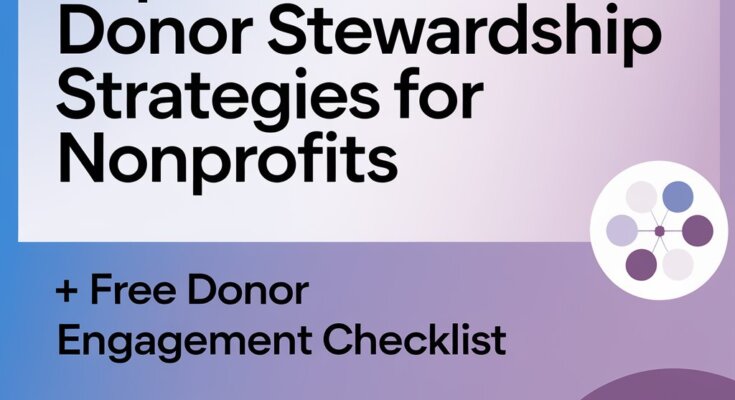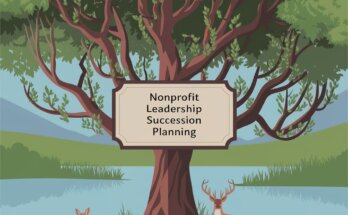Wondering how to create a nonprofit leadership development plan? Nonprofits thrive when they have strong leadership, but what happens when the organization grows faster than its leadership pipeline?
To ensure sustainability and long-term success, every nonprofit needs a solid leadership development plan, whether you’re a small nonprofit or a larger organization, developing future leaders is essential for maintaining your mission and expanding your impact.
In this post, we’ll break down how to create an effective nonprofit leadership development plan that’s practical, easy to understand, and ready for your team to implement.
Why Leadership Development is Crucial for Nonprofits
A leadership development plan is a blueprint that helps your organization identify, train, and support emerging leaders.
This plan is not only about filling roles but also about nurturing talent within your nonprofit, ensuring those in leadership positions are equipped with the right skills to drive your mission forward.
Many nonprofits struggle because their leadership pipeline is underdeveloped. Without a clear plan, the leadership burden often falls on a few individuals, leaving the organization vulnerable to burnouts and leadership gaps.
The key takeaway? A well-executed leadership development plan will ensure the right people are prepared to step into leadership roles when the time comes.
Step 1: Assess Current Leadership Needs and Gaps
The first step in creating your nonprofit leadership development plan is to assess the current leadership structure. This requires an honest evaluation of the existing leadership team and the organization’s future needs.
Key Questions to Ask:
- What leadership roles are critical for your organization?
- Are there any potential leadership gaps?
- What skills are required for these roles?
- Who among your current staff or volunteers could potentially fill these gaps?
Example:
Imagine a nonprofit that provides education to underprivileged communities. The Executive Director (ED) is great at fundraising but lacks operational oversight.
By identifying this gap, the organization can look for someone with strong operational skills within the team to develop into a future leader.
A current project manager might be the perfect candidate to step into this role over time.
Step 2: Identify Emerging Leaders Within the Organization
Leadership doesn’t always mean the person with the highest title. Often, emerging leaders are already working in your nonprofit—they just haven’t had the opportunity to shine.
Start by looking at the people within your organization who have shown initiative, problem-solving abilities, and a passion for your mission. These individuals may not be in traditional leadership roles, but they have the potential to grow with proper guidance.
Practical Tip:
Conduct quarterly check-ins with your staff to discuss their professional goals and aspirations. This helps you spot emerging leaders who are eager to develop their skills.
Let me share a story about a small nonprofit, “Youth for Change,” that almost collapsed because they neglected leadership development.
The ED was passionate but overworked, wearing too many hats. When a health scare forced her to step down, the nonprofit scrambled to find a replacement. Unfortunately, no one was prepared to take over, leading to months of disarray.
After this crisis, “Youth for Change” developed a leadership development plan. They identified a promising program director, Erin, who had strong leadership potential but lacked experience in strategic planning.
With mentorship and leadership training, Erin was ready to step in when the ED eventually retired, and the organization didn’t miss a beat.
This story highlights the importance of identifying leaders before you desperately need them. Building up emerging leaders ensures your nonprofit has a smooth transition when leadership changes happen.
Step 3: Create Tailored Development Programs
Once you’ve identified potential leaders, the next step is to provide tailored development opportunities that align with your organization’s specific needs.
Consider implementing the following strategies:
- Mentorship Programs: Pair your emerging leaders with seasoned executives who can offer guidance and support.
- Leadership Training: Offer workshops, webinars, or courses that cover key leadership topics, such as conflict resolution, strategic planning, and financial management.
- On-the-Job Training: Give emerging leaders more responsibilities by involving them in high-stakes projects. This practical experience is invaluable for preparing them for leadership roles.
Practical Example:
Let’s say you’ve identified a development coordinator as a potential future Director of Development. You could create a mentorship program where they shadow the current director, attend board meetings, and help develop fundraising strategies.
This hands-on learning experience not only builds their confidence but also helps them understand the nuances of leadership within your organization.
Step 4: Encourage Continuous Feedback and Self-Reflection
Feedback is a critical part of any leadership development plan. Leaders need to know where they stand and how they can improve.
Encourage open communication within the organization, where employees feel comfortable discussing their growth. Make feedback a two-way street, where leaders also reflect on their challenges and seek out areas for self-improvement.
Example of Continuous Feedback:
At a nonprofit animal shelter, the board conducts an annual 360-degree review for all senior staff members. During this process, feedback is collected from employees, peers, and supervisors. One of the senior staff members, Jamie, was a compassionate but indecisive leader. After receiving feedback, she worked with a mentor to improve her decision-making skills, making her a stronger, more effective leader.
Step 5: Plan for Succession
Every nonprofit leadership development plan should include a succession plan to ensure that leadership transitions are smooth. Succession planning is critical for nonprofits because leadership transitions can be disruptive if they aren’t handled properly.
A succession plan outlines who will take over key roles in the event of retirement, resignation, or an unexpected departure. It also provides a roadmap for developing those successors.
Practical Succession Planning Tip:
Create a succession chart that lists all critical leadership positions and their potential successors. Update this chart regularly based on performance reviews and developmental milestones.
Step 6: Offer External Development Opportunities
Encouraging leaders to attend external leadership programs can be a great way to expose them to new ideas and best practices in nonprofit leadership. Many nonprofits make the mistake of relying solely on internal development, but external opportunities can provide fresh perspectives and inspire innovation.
These opportunities might include attending nonprofit leadership conferences, enrolling in leadership courses, or even participating in peer exchange programs with other nonprofits.
Example:
The Nonprofit Leadership Alliance offers a range of certification programs tailored for nonprofit leaders. By sending one of your team members to a certification course, you’re not only investing in their growth but also bringing back valuable knowledge to your organization.
Step 7: Develop a Culture of Leadership at Every Level
Leadership shouldn’t be confined to the executive team. Instead, create a culture of leadership where everyone in the organization feels empowered to take initiative, contribute ideas, and grow in their roles.
When leadership is encouraged at all levels, staff members are more likely to engage, take ownership of their work, and help the nonprofit achieve its mission. Foster this culture by celebrating small wins, recognizing leadership qualities in all team members, and encouraging collaboration.
Practical Example:
A nonprofit dedicated to homelessness created a staff empowerment program where every employee could lead a small initiative or project. This program helped build confidence and leadership skills among team members at every level, and it uncovered unexpected talent within the organization.
The Role of the Board in Leadership Development
It’s not just the executive team that needs a leadership development plan—the board of directors plays a crucial role in the overall leadership of the nonprofit. Ensure that board members are actively involved in leadership development, both for themselves and the organization.
Action Steps for the Board:
- Ensure that the board has a clear leadership pipeline for recruiting new board members with diverse skills.
- Conduct annual evaluations to assess the effectiveness of board leadership.
- Create opportunities for board members to mentor emerging leaders within the organization.
A Strong Leadership Pipeline is Key to Nonprofit Success
Developing a strong leadership pipeline is an investment in the future of your nonprofit. By identifying emerging leaders, offering tailored development programs, and fostering a culture of leadership, you’re ensuring that your organization can thrive even as leadership transitions occur.
Your nonprofit leadership development plan is more than a document—it’s a strategy for sustainability. Start small, evaluate regularly, and continuously invest in your team.
Call to Action
Looking for more expert tips and resources to help your nonprofit thrive?
Subscribe to the Nonprofit Navigators Newsletter today! Stay up to date on the latest strategies in nonprofit management, leadership development, fundraising, and more.
Plus, as a bonus, download our free guide “Top 10 Donor Stewardship Strategies for Nonprofits + Free Donor Engagement Checklist” to help you strengthen relationships with your donors and ensure long-term support for your mission.
Let’s build the future of your nonprofit together—one leader at a time.





Thanks for revealing your ideas on this blog. Likewise, a delusion regarding the financial institutions intentions if talking about foreclosure is that the traditional bank will not have my installments. There is a specific amount of time that the bank will require payments in some places. If you are far too deep in the hole, they will commonly call that you pay that payment 100 . However, that doesn’t mean that they will have any sort of installments at all. Should you and the loan company can be capable to work anything out, this foreclosure approach may cease. However, when you continue to miss payments wih the new plan, the home foreclosure process can pick up where it left off.